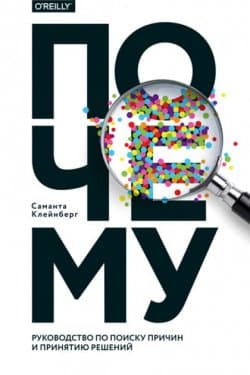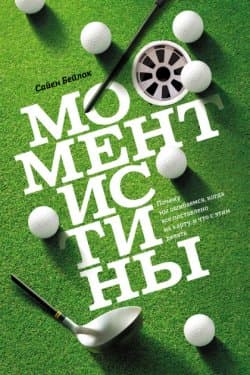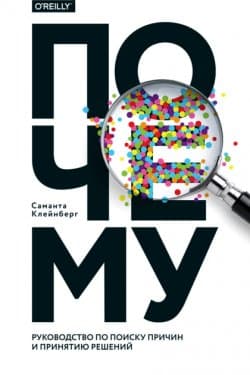Почему - Саманта Клейнберг (2017)
-
Год:2017
-
Название:Почему
-
Автор:
-
Жанр:
-
Язык:Русский
-
Страниц:160
-
Рейтинг:
-
Ваша оценка:
Автор показывает, что такое причинно-следственная связь, поясняет, почему в ее определении мы часто ошибаемся, как можно принимать верные решения. Благодаря этой книге вы научитесь анализировать информацию, выявлять причинно-следственные связи, объединять прошлое, предсказывать будущее.
Книга будет интересна философам, аналитикам, экономистам, медикам, юристам, начинающим ученым.
Почему - Саманта Клейнберг читать онлайн бесплатно полную версию книги
Caporael, L. R. (1976). Ergotism: The Satan Loosed in Salem. Science, 192(4234): 21–26.
Carels, R. A., Konrad, K., and Harper, J. (2007). Individual differences in food perceptions and calorie estimation: An examination of dieting status, weight, and gender. Appetite, 49(2): 450–458.
Carey, B. (2012). Father’s Age Is Linked to Risk of Autism and Schizophrenia. The New York Times, August: p. A1.
Carey, B. (2013). Sleep Therapy Seen as an Aid for Depression. The New York Times, November: p. A1.
Carpenter, C. E. (1932). Workable Rules for Determining Proximate Cause. California Law Review, 20(3): 229–259.
Cartwright, N. (1999). Causal Diversity and the Markov Condition. Synthese, 121(1–2): 3–27.
Cartwright, N. (2001). What Is Wrong with Bayes Nets? The Monist, 84(2): 242–264.
Cartwright, N. (2002). Against Modularity, the Causal Markov Condition, and Any Link Between the Two: Comments on Hausman and Woodward. British Journal for the Philosophy of Science, 53(3): 411–453.
Cartwright, N. (2004). Causation: One Word, Many Things. Philosophy of Science, 71(5): 805–819.
Cartwright, N. (2012). Presidential Address: Will This Policy Work for You? Predicting Effectiveness Better: How Philosophy Helps. Philosophy of Science, 79(5): 973–989.
Chambers, C. D., Feredoes, E., Muthukumaraswamy, S. D., and Etchells, P. J. (2014). Instead of “playing the game” it is time to change the rules: Registered Reports at AIMS Neuroscience and beyond. AIMS Neuroscience, 1(1): 4–17.
Charney, E. and English, W. (2012). Candidate Genes and Political Behavior. American Political Science Review, 106(1): 1–34.
Charniak, E. (1991). Bayesian Networks without Tears. AI magazine, 12(4): 50–63.
Cheng, P. W. (1997). From covariation to causation: A causal power theory. Psychological review, 104(2): 367–405.
Cheng, P. W. and Novick, L. R. (1990). A probabilistic contrast model of causal induction. Journal of Personality and Social Psychology, 58(4): 545–567.
Cheng, P. W. and Novick, L. R. (1992). Covariation in natural causal induction. Psychological Review, 99(2): 365–382.
Cherry, W. H. and Oldford, R. W. (2003). Picturing Probability: The poverty of Venn diagrams, the richness of Eikosograms. Unpublished manuscript.
Choi, I., Dalal, R., Chu, K. P., and Park, H. (2003). Culture and Judgement of Causal Relevance. Journal of Personality and Social Psychology, 84(1): 46–59.
Choi, I., Nisbett, R. E., and Norenzayan, A. (1999). Causal Attribution Across Cultures: Variation and Universality. Psychological Bulletin, 125(1): 47–63.
Chrystal, K. A. and Mizen, P. (2003). Goodhart’s Law: Its origins, meaning and implications for monetary policy. In P. Mizen (ed.), Central Banking, Monetary Theory and Practice: Essays in Honour of Charles Goodhart, vol. 1, pp. 221–243. Edward Elgar Publishing, Northampton, MA.
Chua, H. F., Boland, J. E., and Nisbett, R. E. (2005). Cultural variation in eye movements during scene perception. Proceedings of the National Academy of Sciences, 102(35): 12629–12633.
Claxton, A. J., Cramer, J., and Pierce, C. (2001). A systematic review of the associations between dose regimens and medication compliance. Clinical Therapeutics, 23(8): 1296–1310.
Cohen, J. (2011). Chronic fatigue syndrome researcher fired amidst new controversy. Science. Retrieved from.
Cohen, L. B., Rundell, L. J., Spellman, B. A., and Cashon, C. H. (1999). Infants’ perception of causal chains. Psychological Science, 10(5): 412–418.
Collins, H. and Pinch, T. (2008). Dr. Golem: How to Think about Medicine. University of Chicago Press, Chicago.
Conley, R. H. and Conley, J. M. (2009). Stories from the Jury Room: How Jurors Use Narrative to Process Evidence. Studies in Law, Politics, and Society, 49(2): 25–56.
 Почему они не работают? Новый взгляд на мотивацию сотрудников Сьюзен Фаулер
Почему они не работают? Новый взгляд на мотивацию сотрудников Сьюзен Фаулер
 Королевство Аманда Стивенс
Королевство Аманда Стивенс
 Почему Саманта Клейнберг
Почему Саманта Клейнберг
 Момент истины. Почему мы ошибаемся, когда все поставлено на карту, и что с этим делать? Сайен Бейлок
Момент истины. Почему мы ошибаемся, когда все поставлено на карту, и что с этим делать? Сайен Бейлок
 Почему. Руководство по поиску причин и принятию решений Саманта Клейнберг
Почему. Руководство по поиску причин и принятию решений Саманта Клейнберг
 Здравый смысл врет. Почему не надо слушать свой внутренний голос Уоттс Дункан
Здравый смысл врет. Почему не надо слушать свой внутренний голос Уоттс Дункан

 Пир теней
Пир теней  Князь во все времена
Князь во все времена  Когда порвется нить
Когда порвется нить  Пока я здесь
Пока я здесь 



